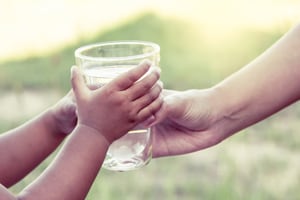
In the last two years, significant national attention has been focused on the lead-contaminated water in Flint, Michigan, and the health consequences for Flint residents, in particular the children. But Flint is not an isolated instance of lead problems. Lead is present in water supplies across the country, in homes and schools, endangering the health […]
In the last two years, significant national attention has been focused on the lead-contaminated water in Flint, Michigan, and the health consequences for Flint residents, in particular the children. But Flint is not an isolated instance of lead problems. Lead is present in water supplies across the country, in homes and schools, endangering the health of children.
According to the Environmental Protection Agency (EPA) and the Centers for Disease Control and Prevention (CDC), there is no safe blood lead level in children. But USA Today has reported that hundreds of schools across the country have lead-tainted water, exposing students to the toxic metal. Compounding the problem, many of these children are also exposed to lead in their homes. Lead paint—a source of lead exposure—is more common in homes built before 1978.
No Safe Lead Level for Children
The CDC explains that lead is toxic to humans and can interfere with the development of nearly every system in a child’s body. Lead exposure is particularly dangerous for young children and fetuses because their brains and nervous systems are developing. Lead exposure can affect a child’s IQ, the ability to pay attention, and, ultimately, the child’s academic achievement. Even low levels of lead in the blood can cause problems. Because lead exposure often occurs with no obvious symptoms, it frequently goes unrecognized. Lead exposure cannot be corrected therefore it is critical to assure that children are not exposed to lead in the first place. Families with concerns children who have been exposed to lead call Parker Waichman, and an attorney can answer questions about what to do next.
Children can be exposed to lead from sources including paint, gasoline, solder, and everyday products like toys and candy. Lead-based paint is the most widespread and dangerous high-dose source of lead exposure for young children, the CDC warns.
Protecting Children from Lead
The first step to protecting children from lead exposure is to make sure the family’s home is free of lead. Older homes more frequently have lead paint and lead water pipes and children from poor and immigrant families are more likely to live in older, less well-maintained buildings. The language barrier can make it difficult for immigrant families to communicate effectively with landlords and public agencies about lead and other health risks in their homes.
Household dust can be a major source of lead. The CDC recommends regularly wet-mopping floors and wet-wiping horizontal surfaces to eliminate dust that may contain lead. Children should not play in bare soil. The CDC recommends covering bare soil with grass or mulch or providing a sandbox for children to use. Regularly wash children’s hands and toys. Pregnant women and young children should not be present in any home built before 1978 that is undergoing renovation. They should not come in contact with old paint or debris.
Many states and cities have lead programs that include lead inspection, lead removal, and testing for children. New York State, for example, requires that all children be tested for lead at ages 1 and 2, and until age 6, at every well-child visit, the parent or guardian should be asked about contact the child may have had with lead. All parents can have their children tested for lead and if the test shows lead in the blood, the parents should find the source and see that it is eliminated. The CDC website has information about lead regulations and programs in each state.

Lead Contamination has Become a Nationwide Problem
Parents should also ask questions about lead exposure at their children’s schools and day care facilities, especially if the school or day care is housed in an older building that may get its water through a system with lead pipes. Lead in the water has been a hazard in school districts around the country, including Washington DC, Seattle, Los Angeles, and Newark, New Jersey. Baltimore schools have used bottled water for drinking and cooking since 2007. Camden, New Jersey has used bottled water for 14 years, the New York Times reports.
In 1986 Congress set the maximum level of lead in pipes and fixtures at 8 percent, the Times reports. Congress lowered the limit to 0.25 percent starting in 2014. Federal law does not require schools to test their water if the water comes from a public water utility. Public health officials are urging Congress and state legislatures to pass laws requiring regular lead testing in school water and public disclosure of the results.
Help for Lead Exposure
If your child or children you know have been exposed to lead at home or at school, the attorneys at Parker Waichman are here to help. Please contact Parker Waichman LLP for a free, no obligation case evaluation. To reach the firm, fill out the contact form or call 1-800-YOURLAWYER (1-800-968-7529).


